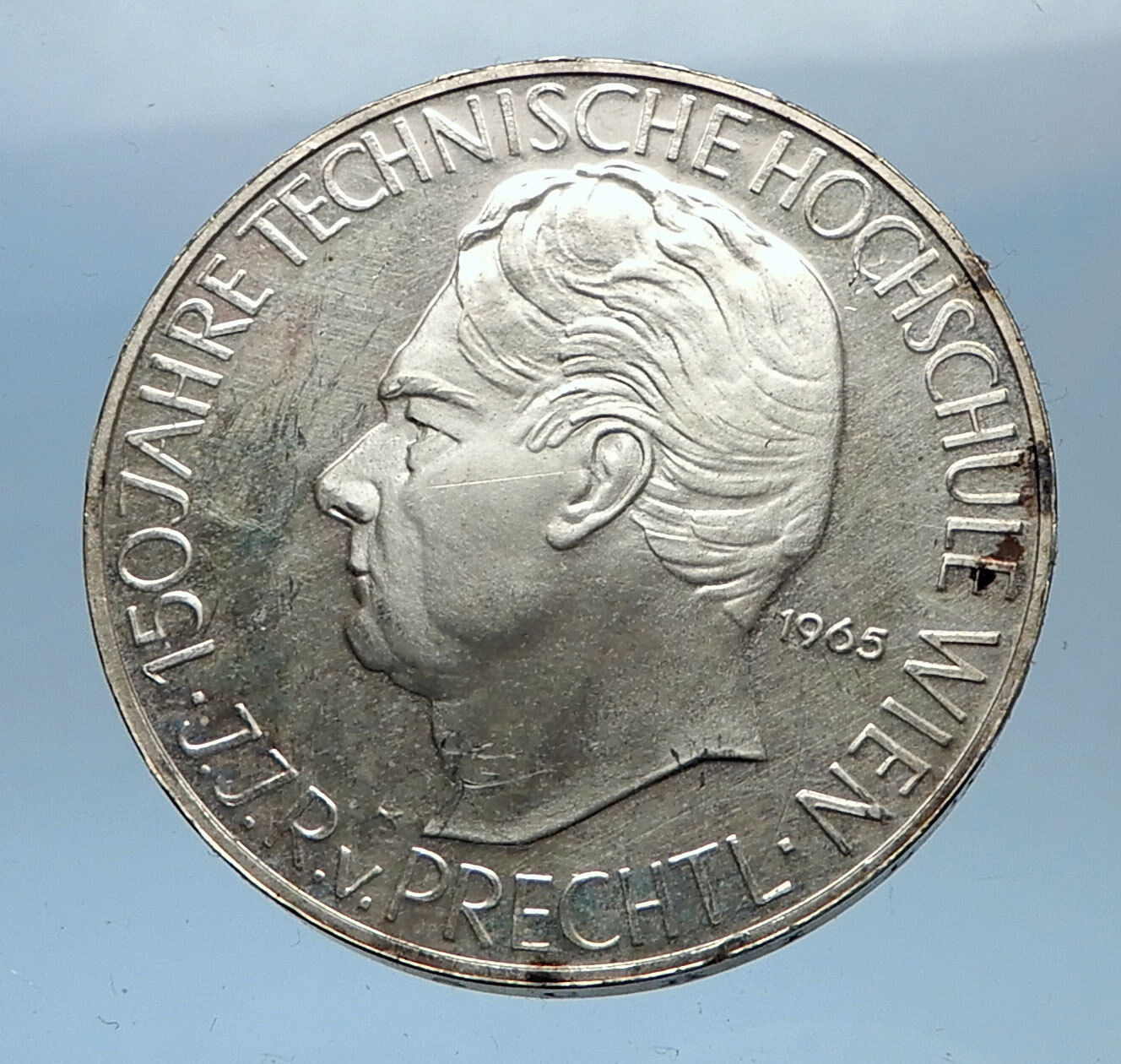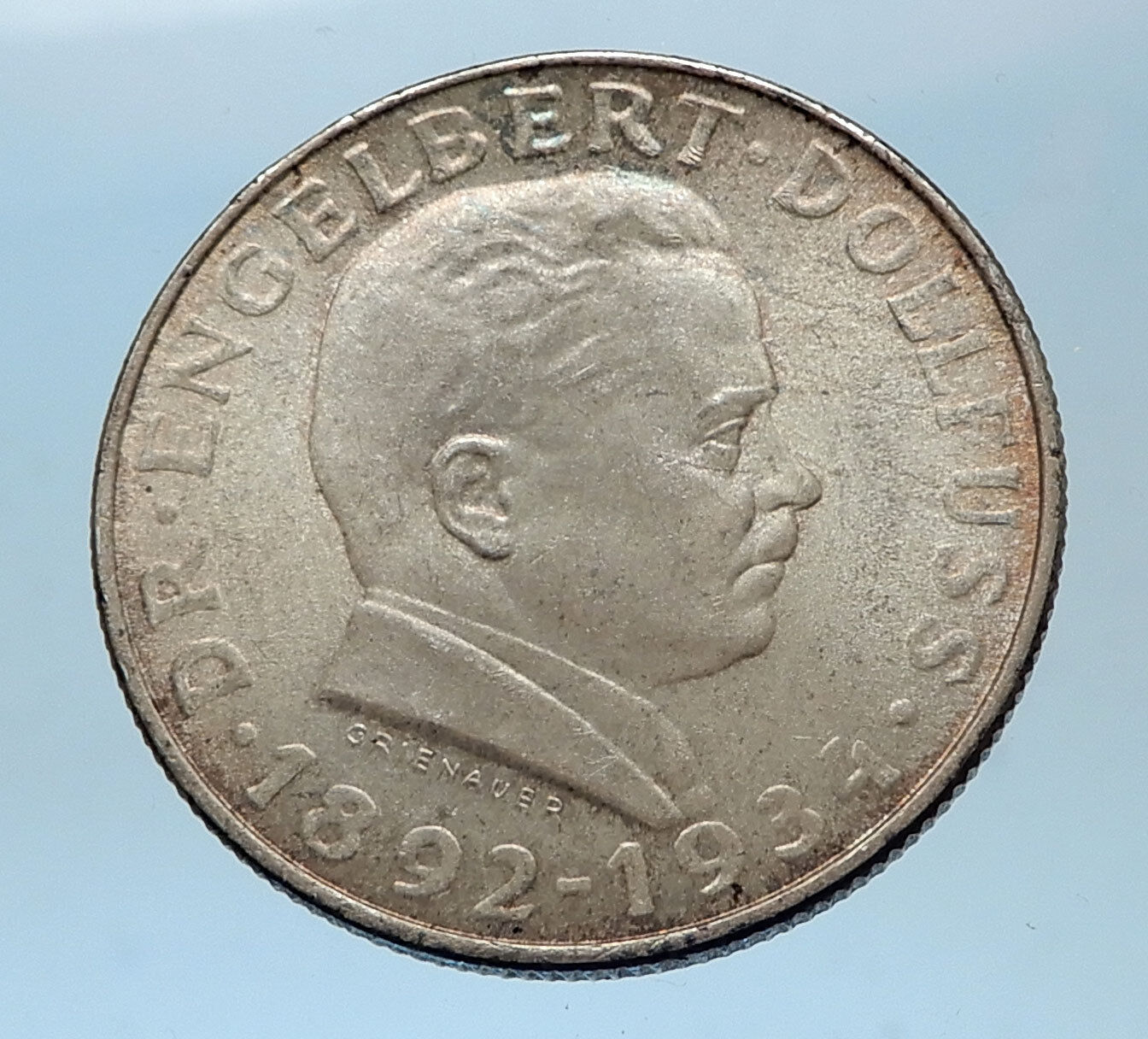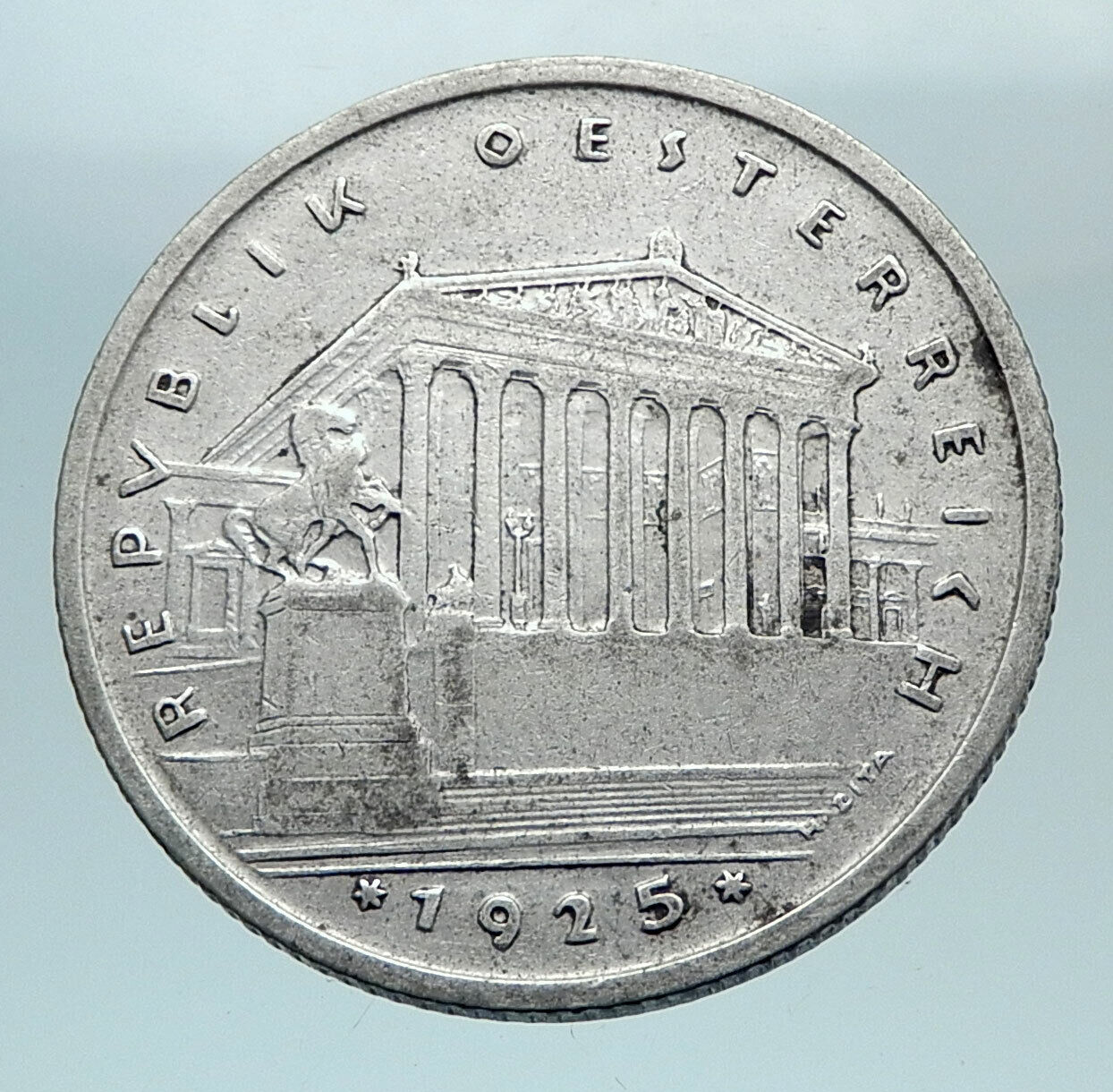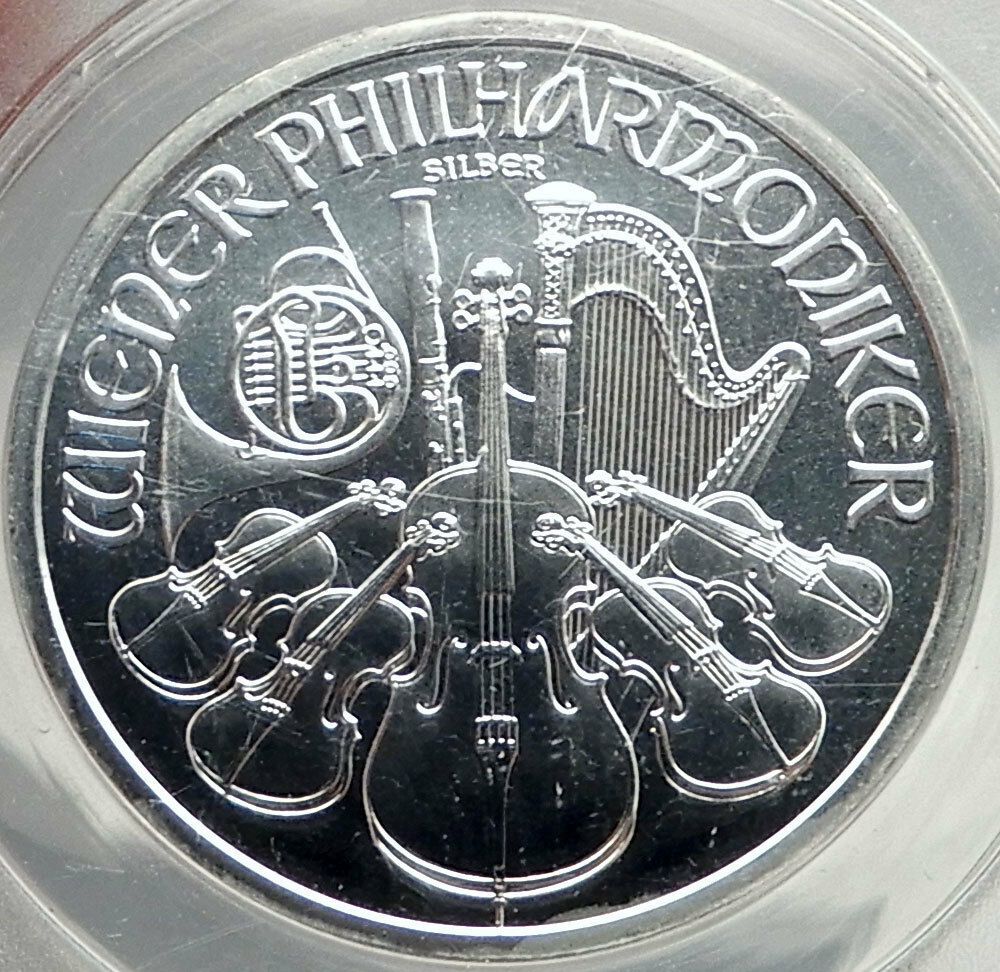|
Austria – 100th Anniversary of the Death of Archduke Johann
1959 Silver 25 Schilling 30mm (13.99 grams) 0.800 Silver (0.3344 oz. ASW)
Reference: KM# 2887
REPUBLIK ÖSTERREICH 25 SCHILLING, Dragon within 3/4 circle of shields, larger Austrian shield lower left, value to right of this.
ERZHERZOG JOHANN 1782-1859 1959, Collared head of Archduke Johann, right, collar divides date. Centennial – Death of Archduke Johann, military leader in the french wars.
Edge Lettering: FUENFZIG SCHILLING
You are bidding on the exact item pictured, provided with a Certificate of Authenticity and Lifetime Guarantee of Authenticity.
 Archduke John of Austria (German: Erzherzog Johann Baptist Joseph Fabian Sebastian von Österreich; 20 January 1782 – 11 May 1859), a member of the House of Habsburg-Lorraine, was an Austrian field marshal and imperial regent (Reichsverweser) of the short-lived German Empire during the Revolutions of 1848. Archduke John of Austria (German: Erzherzog Johann Baptist Joseph Fabian Sebastian von Österreich; 20 January 1782 – 11 May 1859), a member of the House of Habsburg-Lorraine, was an Austrian field marshal and imperial regent (Reichsverweser) of the short-lived German Empire during the Revolutions of 1848.
John was born in Florence, the thirteenth child of the Habsburg grand duke Leopold of Tuscany and Maria Louisa of Spain. He was baptized with the name of John Baptist Joseph Fabian Sebastian, after the patron saint of the Tuscan capital. In 1790, Leopold succeeded his brother Joseph II as Holy Roman Emperor and his family moved from the Grand Duchy of Tuscany to the Imperial court in Vienna. Only two years later, John’s elder brother Francis II ascended the Imperial throne.
John’s native language was Italian, he learned to speak French and German fluently. Educated by the Swiss historian Johannes von Müller, he developed wide-ranging skills and interests, especially in the history and geography of the Alpine countries.
Military service
During the Napoleonic Wars, John was given command of the Austrian army in September 1800, despite his personal reluctance to assume the position. He showed personal bravery in the War of the Second Coalition, but his troops were crushed at the Battle of Hohenlinden on 3 December. Demoralized by defeat, the army nearly disintegrated in the subsequent retreat, which was only stopped by an armistice arranged on 22 December. After the Peace of Lunéville in 1801, Archduke John was made General Director of the Engineering and Fortification Service, and later commander of the Theresian Military Academy in Wiener Neustadt.
In the War of the Third Coalition, John again fought the French and Bavarian forces. From 1805 he directed an able defence of several Tyrolean passes against the French and was awarded the Commander Cross of the Military Order of Maria Theresa. However, according to the Peace of Pressburg, Austria had to cede Tyrol and Vorarlberg to Bavaria. John remained obliged to Tyrol and maintained friendly contact with Baron Joseph Hormayr who forged a resistance movement against the Bavarian occupation. In 1808, John pressed for the creation of Tyrolean Landwehr forces based on the success of the Prussian Landwehr, which played a vital role in the Tyrolean Rebellion led by Andreas Hofer.
At the commencement of the War of the Fifth Coalition in 1809 he became commander of the Army of Inner Austria, fighting against the French forces of Eugène de Beauharnais in Italy. Under his command were the VIII Armeekorps led by Albert Gyulai and the IX Armeekorps headed by Albert’s brother Ignaz Gyulai. After winning a significant victory at the Battle of Sacile on 16 April 1809, his army advanced almost to Verona. Having detached forces to besiege Venice and other fortresses, John’s army was soon outnumbered by Eugène’s heavily reinforced host. Worse, news of the Austrian defeat at the Battle of Eckmühl reached him and compelled him to order a retreat. Before withdrawing, he fought off Franco-Italian attacks at the Battle of Caldiero between 27 and 30 April. Attempting to blunt the Franco-Italian pursuit, he stood to fight on 8 May and was beaten at the Battle of Piave River. Trying to defend the entire border, he sent Ignaz Gyulai to defend Ljubljana (Laibach) in Carniola, while holding Villach in Carinthia with his own forces. Eugène’s pursuit overran the frontier defenses at the Battle of Tarvis and wrecked a column of hoped-for reinforcements at the Battle of Sankt Michael. Forced to flee northeast into Hungary, John offered battle again but was defeated at Raab on 14 June 1809. Ordered to join his brother Archduke Charles at the Battle of Wagram on 5 and 6 July, John’s small army arrived too late to avert an Austrian defeat. His brother criticized him for tardiness.
After the conclusion of the campaign, John again evolved plans for a widespread rebellion. However, upon the Treaty of Schönbrunn Austrian policies under Minister Klemens von Metternich sought a rapprochement to France. John’s friend Baron Hormayr and other conspirators were arrested, the archduke himself effectively was sidelined and retired to his estates in Thernberg.
Post military
John, tired of warfare, turned away from the military and developed a great interest for nature, technology and agriculture. He collected minerals and was active as an alpinist and hunter in the Duchy of Styria. In his early days Archduke Johann and his brother Louis had the habit of travelling to France, where the latter married Madame de Gueroust. In 1815, on his visit to the United Kingdom, John received a Doctor honoris causa degree from the University of Edinburgh.
In the history of Styria, he is remembered as a great modernizer and became an important figure of identification for Styrians. His proximity to the people is given evidence to by his many contacts with the common man, by wearing the local Tracht, the Steireranzug, and by collecting and promoting the material and spiritual culture of the country. In 1811, he founded the Joanneum Museum in Graz and the predecessor of Graz University of Technology. Some other foundations were initiated by him, such as the Styrian State Archive 1817, the Steiermärkisch-Ständische Montanlehranstalt, which was founded in 1840 in Vordernberg and later became the University of Leoben, the Styrian Society for Agriculture 1819, the Mutual Fire Insurance, the Styrian Building Society, the Landesoberrealschule in 1845 and the Society for Styrian History in 1850. His routing of the Austrian Southern Railway from Vienna to Triest over the Semmering Pass and through the Mura and Mürz valleys to Graz is particularly notable. The inheritance of his maternal uncle Duke Albert Casimir of Teschen enabled him to acquire a tin factory in Krems near Voitsberg and coal mines near Köflach, thereby he also became an industrialist. In 1840, he bought the Stainz dominion, where he was also freely elected as mayor in 1850. He was already the lord of the Brandhof manor in Mariazell.
In 1829, he married Anna Plochl [de] (1804-1885), the daughter of Jakob Plochl, postmaster of Aussee, and his wife Maria Anna Pilz, during a nocturnal ceremony in Brandhof. By this morganatic marriage, John was excluded from succession to the throne. Emperor Francis elevated Anna to a “Baroness of Brandhofen” in 1834 and in 1839 she gave birth to a son, Franz, the only child from the marriage. His descendants were styled “Counts of Meran” and “Barons of Brandhofen”, Proprietors of Stainz and Brandhofen.
John was also a passionate mountaineer in the Eastern Alps and attempted to be the first to climb the Großvenediger. For that reason, the Erzherzog-Johann-Hütte (Adlersruhe) at the Grossglockner, and the Archduke John’s Vanilla Orchid (Nigritella rubra subsp. archiducis-joannis), an orchid growing on mountain meadows, are named after him.
Imperial regent
Even though Johann did not consider himself a liberal, he promoted some liberal ideas. He was often in conflict with the Habsburg court, especially because of his morganatic marriage, though he never openly rebelled. He had earned great recognition in the Styrian lands, moreover he gained general acceptance by his jovial manners and his marriage with a middle-class woman.
Upon the March Revolution of 1848, the Frankfurt Parliament discussed the appointment of an all-German government replacing the Federal Convention. On a proposal by the liberal politician Heinrich von Gagern, the assembly on 28 June 1848 voted for the establishment of a central authority (Provisorische Zentralgewalt) and on the next day a broad majority elected Archduke John regent of the realm (Reichsverweser).
Archduke John accepted the nomination as head of the short-lived German Empire and on 12 July 1848 the delegates of the Federal Convention, in response to public pressure, ceded their powers to him. On July 15, he appointed the ministers Anton von Schmerling, Johann Gustav Heckscher and Eduard von Peucker to office, completed by Prince Carl of Leiningen as minister president and head of government. Nevertheless, his political office did not offer many opportunities, though all laws had to be signed by him.
First attempts by the government to obtain supreme command of the German Federal Army faced entrenched resistance from the member states. To strengthen support, the left-wing politician Robert von Mohl joined the Leiningen Cabinet on August 9. Leiningen himself resigned on September 6, after the Frankfurt assembly rejected to ratify the armistice of Malmö, signed by Prussia during the First Schleswig War. Minister Anton von Schmerling acted as head of government, until from November 1848 the cabinet gradually lost the support of the centrist Casino faction and finally its majority in parliament. Schmerling was forced to resign and on December 17, Archduke John had to appoint Heinrich von Gagern new minister president, though he opposed his ‘Lesser German’ ideas.
Archduke John did not take part in the draft of the Frankfurt Constitution, which was adopted on 28 March 1849 after lengthy negotiations led by Gagern, and he pronounced against the strong position of Prussia. Determined to resign, he was once more turned over by the ministers. When in April 1849 King Frederick William IV of Prussia disappointed Gagern’s hopes and openly rejected the Constitution, Archduke John remained passive and Gagern handed in his resignation on May 10. John insisted that he would exert central authority out of a sense of obligation, nevertheless he departed for a prolonged stay at the health resort of Bad Gastein. After the final failure of the March Revolution, he finally resigned from his office on 20 December 1849.
When Archduke Johann came back to Frankfurt on a visit in 1858, he openly regretted the failure of the German unification. He died in 1859 in Graz, where a fountain erected in his honour dominates the central square. He is buried in Schenna near Meran. He was the great-grandfather of noted conductor Nikolaus Harnoncourt (1929-2016).
  Austria, officially the Republic of Austria (German: Republik Österreich), is a federal republic and a landlocked country of over 8.5 million people in Central Europe. It is bordered by the Czech Republic and Germany to the north, Hungary and Slovakia to the east, Slovenia and Italy to the south, and Switzerland and Liechtenstein to the west. The territory of Austria covers 83,879 square kilometres (32,386 sq mi). Austria’s terrain is highly mountainous, lying within the Alps; only 32% of the country is below 500 metres (1,640 ft), and its highest point is 3,798 metres (12,461 ft). The majority of the population speak local Bavarian dialects of German as their native language, and Austrian German in its standard form is the country’s official language. Other local official languages are Hungarian, Burgenland Croatian, and Slovene. Austria, officially the Republic of Austria (German: Republik Österreich), is a federal republic and a landlocked country of over 8.5 million people in Central Europe. It is bordered by the Czech Republic and Germany to the north, Hungary and Slovakia to the east, Slovenia and Italy to the south, and Switzerland and Liechtenstein to the west. The territory of Austria covers 83,879 square kilometres (32,386 sq mi). Austria’s terrain is highly mountainous, lying within the Alps; only 32% of the country is below 500 metres (1,640 ft), and its highest point is 3,798 metres (12,461 ft). The majority of the population speak local Bavarian dialects of German as their native language, and Austrian German in its standard form is the country’s official language. Other local official languages are Hungarian, Burgenland Croatian, and Slovene.
 The origins of modern-day Austria date back to the time of the Habsburg dynasty when the vast majority of the country was a part of the Holy Roman Empire. From the time of the Reformation, many Northern German princes, resenting the authority of the Emperor, used Protestantism as a flag of rebellion. The Thirty Years War, the influence of the Kingdom of Sweden and Kingdom of France, the rise of the Kingdom of Prussia, and the Napoleonic invasions all weakened the power of the Emperor in the North of Germany, but in the South, and in non-German areas of the Empire, the Emperor and Catholicism maintained control. During the 17th and 18th centuries, Austria was able to retain its position as one of the great powers of Europe and, in response to the coronation of Napoleon as the Emperor of the French, the Austrian Empire was officially proclaimed in 1804. Following Napoleon’s defeat, Prussia emerged as Austria’s chief competitor for rule of a larger Germany. Austria’s defeat by Prussia at the Battle of Königgrätz, during the Austro-Prussian War of 1866 cleared the way for Prussia to assert control over the rest of Germany. In 1867, the empire was reformed into Austria-Hungary. After the defeat of France in the 1870 Franco-Prussian War, Austria was left out of the formation of a new German Empire, although in the following decades its politics, and its foreign policy, increasingly converged with those of the Prussian-led Empire. During the 1914 July Crisis that followed the assassination of Archduke Franz Ferdinand of Austria, Germany guided Austria in issuing the ultimatum to Serbia that led to the declaration of World War I. The origins of modern-day Austria date back to the time of the Habsburg dynasty when the vast majority of the country was a part of the Holy Roman Empire. From the time of the Reformation, many Northern German princes, resenting the authority of the Emperor, used Protestantism as a flag of rebellion. The Thirty Years War, the influence of the Kingdom of Sweden and Kingdom of France, the rise of the Kingdom of Prussia, and the Napoleonic invasions all weakened the power of the Emperor in the North of Germany, but in the South, and in non-German areas of the Empire, the Emperor and Catholicism maintained control. During the 17th and 18th centuries, Austria was able to retain its position as one of the great powers of Europe and, in response to the coronation of Napoleon as the Emperor of the French, the Austrian Empire was officially proclaimed in 1804. Following Napoleon’s defeat, Prussia emerged as Austria’s chief competitor for rule of a larger Germany. Austria’s defeat by Prussia at the Battle of Königgrätz, during the Austro-Prussian War of 1866 cleared the way for Prussia to assert control over the rest of Germany. In 1867, the empire was reformed into Austria-Hungary. After the defeat of France in the 1870 Franco-Prussian War, Austria was left out of the formation of a new German Empire, although in the following decades its politics, and its foreign policy, increasingly converged with those of the Prussian-led Empire. During the 1914 July Crisis that followed the assassination of Archduke Franz Ferdinand of Austria, Germany guided Austria in issuing the ultimatum to Serbia that led to the declaration of World War I.
After the collapse of the Habsburg (Austro-Hungarian) Empire in 1918 at the end of World War I, Austria adopted and used the name the Republic of German-Austria (Deutschösterreich, later Österreich) in an attempt for union with Germany, but was forbidden due to the Treaty of Saint-Germain-en-Laye (1919). The First Austrian Republic was established in 1919. In the 1938 Anschluss, Austria was occupied and annexed by Nazi Germany. This lasted until the end of World War II in 1945, after which Germany was occupied by the Allies and Austria’s former democratic constitution was restored. In 1955, the Austrian State Treaty re-established Austria as a sovereign state, ending the occupation. In the same year, the Austrian Parliament created the Declaration of Neutrality which declared that the Second Austrian Republic would become permanently neutral.
Today, Austria is a parliamentary representative democracy comprising nine federal states. The capital and largest city, with a population exceeding 1.7 million, is Vienna. Austria is one of the richest countries in the world, with a nominal per capita GDP of $52,216 (2014 est.). The country has developed a high standard of living and in 2014 was ranked 21st in the world for its Human Development Index. Austria has been a member of the United Nations since 1955, joined the European Union in 1995, and is a founder of the OECD. Austria also signed the Schengen Agreement in 1995, and adopted the euro in 1999.
|





 Archduke John of Austria (German: Erzherzog Johann Baptist Joseph Fabian Sebastian von Österreich; 20 January 1782 – 11 May 1859), a member of the House of Habsburg-Lorraine, was an Austrian field marshal and imperial regent (Reichsverweser) of the short-lived German Empire during the Revolutions of 1848.
Archduke John of Austria (German: Erzherzog Johann Baptist Joseph Fabian Sebastian von Österreich; 20 January 1782 – 11 May 1859), a member of the House of Habsburg-Lorraine, was an Austrian field marshal and imperial regent (Reichsverweser) of the short-lived German Empire during the Revolutions of 1848. 
 Austria, officially the Republic of Austria (German: Republik Österreich), is a federal republic and a landlocked country of over 8.5 million people in Central Europe. It is bordered by the Czech Republic and Germany to the north, Hungary and Slovakia to the east, Slovenia and Italy to the south, and Switzerland and Liechtenstein to the west. The territory of Austria covers 83,879 square kilometres (32,386 sq mi). Austria’s terrain is highly mountainous, lying within the Alps; only 32% of the country is below 500 metres (1,640 ft), and its highest point is 3,798 metres (12,461 ft). The majority of the population speak local Bavarian dialects of German as their native language, and Austrian German in its standard form is the country’s official language. Other local official languages are Hungarian, Burgenland Croatian, and Slovene.
Austria, officially the Republic of Austria (German: Republik Österreich), is a federal republic and a landlocked country of over 8.5 million people in Central Europe. It is bordered by the Czech Republic and Germany to the north, Hungary and Slovakia to the east, Slovenia and Italy to the south, and Switzerland and Liechtenstein to the west. The territory of Austria covers 83,879 square kilometres (32,386 sq mi). Austria’s terrain is highly mountainous, lying within the Alps; only 32% of the country is below 500 metres (1,640 ft), and its highest point is 3,798 metres (12,461 ft). The majority of the population speak local Bavarian dialects of German as their native language, and Austrian German in its standard form is the country’s official language. Other local official languages are Hungarian, Burgenland Croatian, and Slovene. The origins of modern-day Austria date back to the time of the Habsburg dynasty when the vast majority of the country was a part of the Holy Roman Empire. From the time of the Reformation, many Northern German princes, resenting the authority of the Emperor, used Protestantism as a flag of rebellion. The Thirty Years War, the influence of the Kingdom of Sweden and Kingdom of France, the rise of the Kingdom of Prussia, and the Napoleonic invasions all weakened the power of the Emperor in the North of Germany, but in the South, and in non-German areas of the Empire, the Emperor and Catholicism maintained control. During the 17th and 18th centuries, Austria was able to retain its position as one of the great powers of Europe and, in response to the coronation of Napoleon as the Emperor of the French, the Austrian Empire was officially proclaimed in 1804. Following Napoleon’s defeat, Prussia emerged as Austria’s chief competitor for rule of a larger Germany. Austria’s defeat by Prussia at the Battle of Königgrätz, during the Austro-Prussian War of 1866 cleared the way for Prussia to assert control over the rest of Germany. In 1867, the empire was reformed into Austria-Hungary. After the defeat of France in the 1870 Franco-Prussian War, Austria was left out of the formation of a new German Empire, although in the following decades its politics, and its foreign policy, increasingly converged with those of the Prussian-led Empire. During the 1914 July Crisis that followed the assassination of Archduke Franz Ferdinand of Austria, Germany guided Austria in issuing the ultimatum to Serbia that led to the declaration of World War I.
The origins of modern-day Austria date back to the time of the Habsburg dynasty when the vast majority of the country was a part of the Holy Roman Empire. From the time of the Reformation, many Northern German princes, resenting the authority of the Emperor, used Protestantism as a flag of rebellion. The Thirty Years War, the influence of the Kingdom of Sweden and Kingdom of France, the rise of the Kingdom of Prussia, and the Napoleonic invasions all weakened the power of the Emperor in the North of Germany, but in the South, and in non-German areas of the Empire, the Emperor and Catholicism maintained control. During the 17th and 18th centuries, Austria was able to retain its position as one of the great powers of Europe and, in response to the coronation of Napoleon as the Emperor of the French, the Austrian Empire was officially proclaimed in 1804. Following Napoleon’s defeat, Prussia emerged as Austria’s chief competitor for rule of a larger Germany. Austria’s defeat by Prussia at the Battle of Königgrätz, during the Austro-Prussian War of 1866 cleared the way for Prussia to assert control over the rest of Germany. In 1867, the empire was reformed into Austria-Hungary. After the defeat of France in the 1870 Franco-Prussian War, Austria was left out of the formation of a new German Empire, although in the following decades its politics, and its foreign policy, increasingly converged with those of the Prussian-led Empire. During the 1914 July Crisis that followed the assassination of Archduke Franz Ferdinand of Austria, Germany guided Austria in issuing the ultimatum to Serbia that led to the declaration of World War I.




